Small Antennas for Wearable Sensor Networks: Impact of the Electromagnetic Properties of the Textiles on Antenna Performance
Abstract
:1. Introduction
2. Design, Fabrication and Measurement of Small Antennas for W-WSNs
2.1. Initial Antenna Design
2.2. Numerical Evaluation of the Antenna Performance in Free Space and on a Model of the Human Body
2.3. Fabrication of the Antenna Prototype
2.4. Measurements
3. Impact of EM Properties of the Textile Materials on the Performance of the Small Antennas for W-WSNs
3.1. Antenna Designs
3.2. Results and Discussion
4. Conclusions
Author Contributions
Funding
Conflicts of Interest
References
- Atnasova, G.L.; Atanasov, N.T. Impact of electromagnetic properties of textile materials on performance of a low-profile wearable antenna backed by a reflector. In Proceedings of the 2020 International Workshop on Antenna Technology (iWAT), Bucharest, Romania, 25–28 February 2020. [Google Scholar] [CrossRef]
- Atanasov, N.T.; Atanasova, G.L.; Atanasov, B.N. Wearable Textile Antennas with High Body-Area Isolation: Design, Fabrication, and Characterization Aspects. In Modern Printed Circuit Antennas, 1st ed.; Al-Rizzo, H., Ed.; IntechOpen: London, UK, 2020; Volume 1, pp. 1–20. [Google Scholar] [CrossRef] [Green Version]
- Antolin, D.; Medrano, N.; Calvo, B.; Pérez, F. A wearable wireless sensor network for indoor smart environment monitoring in safety applications. Sensors 2017, 17, 365. [Google Scholar] [CrossRef] [PubMed]
- Lin, R.; Kim, H.-J.; Achavananthadith, S.; Kurt, S.A.; Tan, S.C.C.; Yao, H.; Tee, B.C.K.; Lee, J.K.W.; Ho, J.S. Wireless battery-free body sensor networks using near-field-enabled clothing. Nat. Commun. 2020, 11, 1–10. [Google Scholar] [CrossRef] [PubMed] [Green Version]
- Al-Sehemi, A.G.; Al-Ghamdi, A.A.; Dishovsky, N.T.; Atanasov, N.T.; Atanasova, G.L. Design and performance analysis of dual-band wearable compact low-profile antenna for body-centric wireless communication. Int. J. Microw. Wirel. Technol. 2018, 10, 1–11. [Google Scholar] [CrossRef]
- El Attaoui, A.; Hazmi, M.; Jilbab, A.; Bourouhou, A. Wearable wireless sensors network for ECG telemonitoring using neural network for features extraction. Wirel. Presonal Commun. 2019, 111, 1–22. [Google Scholar] [CrossRef]
- Seimeni, M.A.; Tsolis, A.; Alexsandridis, A.A.; Pantelopoulos, S.A. The effects of ground-plane of a textile higher mode microstrip patch antenna on SAR. In Proceedings of the 2020 International Workshop on Antenna Technology (iWAT), Bucharest, Romania, 25–28 February 2020. [Google Scholar] [CrossRef]
- Al-Sehemi, A.G.; Al-Ghamdi, A.A.; Dishovsky, N.T.; Atanasov, N.T.; Atanasova, G.L. Flexible and small wearable antenna for wireless body area network applications. J. Electromagn. Waves Appl. 2017, 31, 1–20. [Google Scholar] [CrossRef]
- Song, Y.; Le Goff, D.; Riondet, G.; Mouthaan, K. Polymer-based 4.2 GHz patch antenna. In Proceedings of the 2020 International Workshop on Antenna Technology, Bucharest, Romania, 25–28 February 2020. [Google Scholar]
- Ashyap, A.Y.I.; Dahlan, S.H.; Abidin, Z.Z.; Dahri, M.H.; Majid, M.K.A.R.H.A.; Kamarudin, M.R.; Yee, S.K.; Jamaluddin, M.H.; Alomainy, A.; Abbasi, Q.H.; et al. Robust and efficient integrated antenna With EBG-DGS enabled wide bandwidth for wearable medical device applications. IEEE Access 2020, 8, 56346–56358. [Google Scholar] [CrossRef]
- Ashyap, A.Y.I.; Marzudi, W.N.N.W.; Abidin, Z.Z.; Dahlan, S.H.; Majid, H.A.; Kamaruddin, M.R. Antenna incorporated with Electromagnetic Bandgap (EBG) for wearable application at 2.4 GHz wireless bands. In Proceedings of the 2016 IEEE Asian-Pacific Conference on Applied Electromagnetics, Langkawi, Kedah, Malaysia, 11–13 December 2016. [Google Scholar] [CrossRef]
- Ashyap, A.Y.I.; Abidin, Z.Z.; Dahlan, S.H.; Majid, H.A.; Shah, S.M.; Alomainy, A. Compact and low-profile textile EBG-based antenna for wearable medical applications. IEEE Antennas Wirel. Propag. Lett. 2017, 16, 2550–2553. [Google Scholar] [CrossRef] [Green Version]
- Del-Rio-Ruiz, R.; Lopez-Garde, J.M.; Legarda, J. Planar taxtile off-body communication antennas: A survey. Electronics 2019, 8, 714. [Google Scholar] [CrossRef] [Green Version]
- Kapse, S.; Gundre, S.B. Fractal shaped dual-band EBG integrated textile antenna. In Proceedings of the 2019 4th International Conference on Recent Trends on Electronics, Information, Communication & Technology (RTEICT-2019), Bengaluru, India, 17–18 May 2019. [Google Scholar] [CrossRef]
- Atanasov, N.T.; Atanasova, G.L.; Stefanov, A.K.; Nedialkov, I.I. A wearable, low-profile, fractal monopole antenna with a reflector for enhancing antenna performance and sar reduction. In Proceedings of the 2019 IEEE MTT-S International Microwave Workshop Series on Advanced Material and Processes for RF and THz Applications (IMWS-AMP), Bochum, Germany, 16–18 July 2019; 2019. [Google Scholar] [CrossRef]
- Alemaryeen, A.; Noghanian, S. Performance analysis of textile AMC antenna on body model. In Proceedings of the 2017 United States National Conference of URSI National Radio Science Meeting (USNC-URSI NRSM), Boulder, CO, USA, 4–7 January 2017. [Google Scholar] [CrossRef]
- Alemaryeen, A.; Noghanian, S. On-body low-profile textile antenna with artificial magnetic conductor. IEEE Trans. Antennas Propag. 2019, 67, 3649–3656. [Google Scholar] [CrossRef]
- Fang, R.; Song, R.; Zhao, X.; Wang, Z.; Qian, W.; He, D. Compact and loa-profile UWB antenna based on graphene-assembled films for wearable applications. Sensors 2020, 20, 2552. [Google Scholar] [CrossRef] [PubMed]
- Androne, A.; Tamas, R.D.; Tasu, S. Influence of the substrate material on the radar cross section of square loop unit cells for frequency selective surfaces. In Proceedings of the 2020 International Workshop on Antenna Technology (iWAT), Bucharest, Romania, 25–28 February 2020. [Google Scholar]
- Zhu, J.; Cheng, H. Recent development of flexible and stretchable antennas for bio-integrated electronics. Sensors 2018, 18, 4364. [Google Scholar] [CrossRef] [Green Version]
- Nepa, P.; Rogier, H. Wearable antennas for off-body links at VHF and UHF bands: Challenges, the state of art, and future trends below 1 GHz. IEEE Antennas Propag. Mag. 2015, 57, 30–52. [Google Scholar] [CrossRef]
- Jiang, Z.H.; Brocker, D.E.; Sieber, P.E.; Werner, D.H. A Compact, low-profile metasurface-enabled antenna for wearable medical body-area network devices. IEEE Trans. Antennas Propag. 2014, 8, 4021–4030. [Google Scholar] [CrossRef]
- Rowell, C.; Lam, E.Y. Mobile-phone antenna design. IEEE Antennas Propag. Mag. 2012, 54, 14–34. [Google Scholar] [CrossRef]
- ICNIRP. Guidelines for limiting exposure to time-varying electric, magnetic, and electromagnetic fields (up to 300 GHz). Health Phys. 1998, 74, 494–522. [Google Scholar]
- IEEE Standards Coordinating Committee. IEEE for Safety Levels with Respect to Human Exposure to Radio Frequency Electromagnetic Fields, 3 kHz to 300 GHz; IEEE Std C95.1-2005; IEEE: New York, NY, USA, 2006. [Google Scholar]
- Al-Naiemy, Y.; Elwi, T.A.; Khaleel, H.R.; Al-Rizzo, H. A systematic approach for the design, fabrication, and testing of microstrip antennas using inkjet printing technology. ISRN Commun. Netw. 2012, 1–11. [Google Scholar] [CrossRef] [Green Version]
- Zhong, J.; Kiourti, A.; Sebastian, T.; Bayram, Y.; Volakis, J.L. Conformal load-bearing spiral antenna on conductive textile threads. IEEE Antennas Wirel. Propag. Lett. 2016, 16, 230–233. [Google Scholar] [CrossRef]
- Balanis, C.A. Antenna Theory Analysis and Design, 2nd ed.; John Wiley & Sons, Inc.: New York, NY, USA, 1996; pp. 839–881. [Google Scholar]
- Arai, H. Measurement of Mobile Antenna Systems, 2nd ed.; Artech House: Boston, MA, USA, 2013; pp. 39–84. [Google Scholar]
- Chen, Z.N. Antennas for Portable Devices, 3rd ed.; John Wiley & Sons, Ltd.: Chichester, UK, 2007; pp. 12–13. [Google Scholar]
- Yilmaz, T.; Foster, R.; Hao, Y. Broadband tissue mimicking phantoms and a patch resonator for evaluating noninvasive monitoring of blood glucose levels. IEEE Trans. Antennas Propag. 2014, 6, 3064–6075. [Google Scholar] [CrossRef]
- Lam, P.T.; Le, T.Q.; Le, N.N.; Nguyen, S.D. Wireless sensing modules for rural monitoring and precision agriculture applications. J. Telecommun. Inf. Technol. 2017, 2, 107–123. [Google Scholar] [CrossRef] [Green Version]
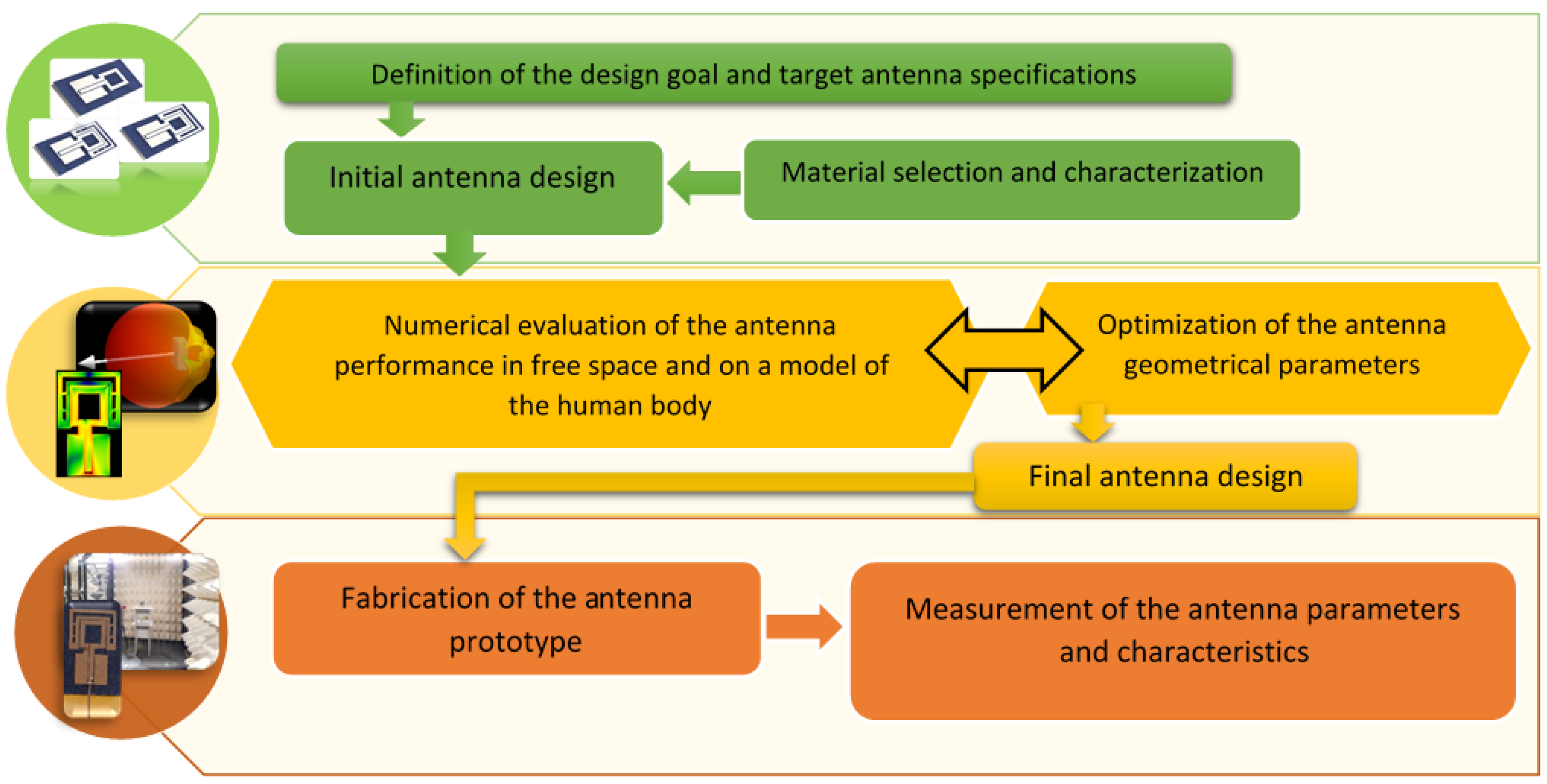
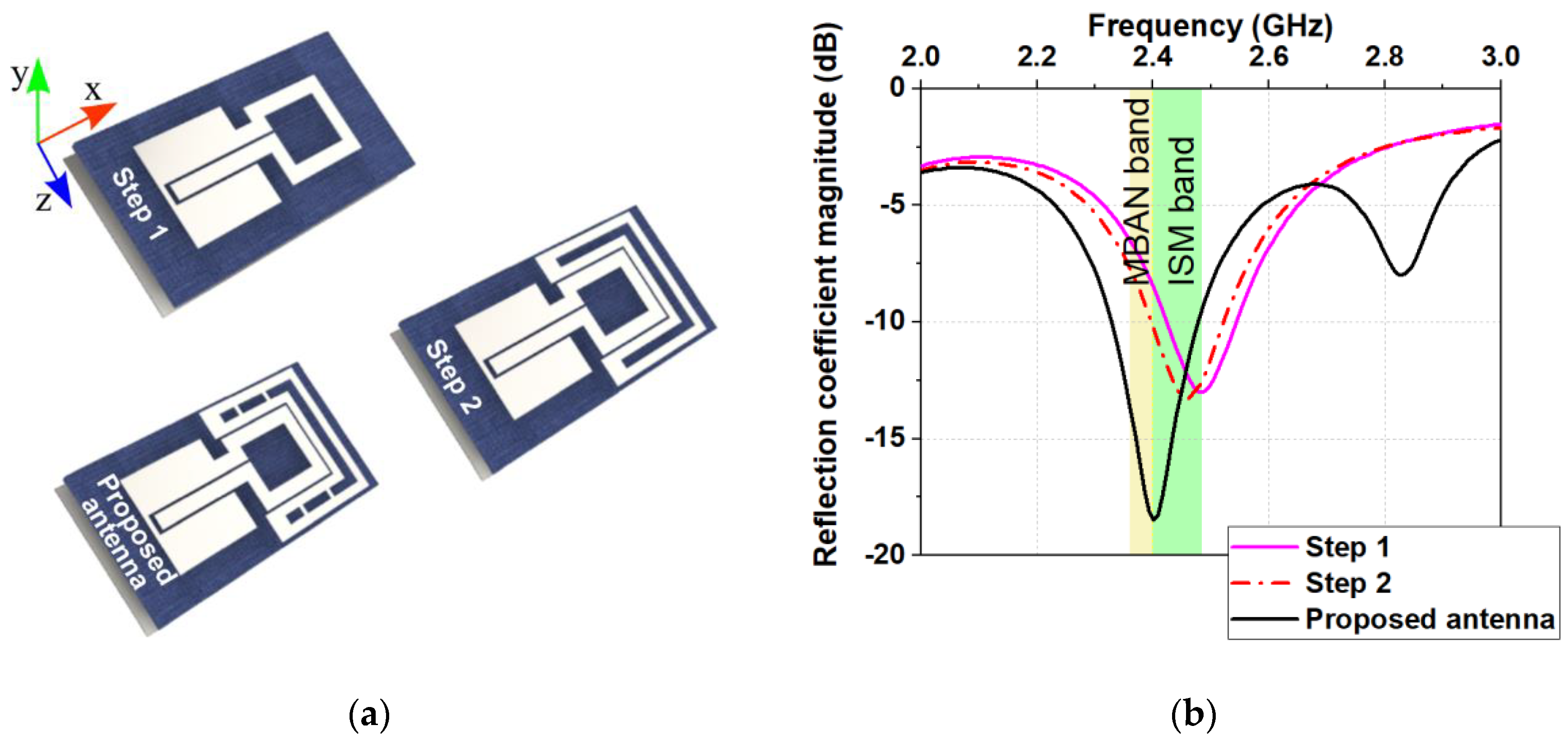

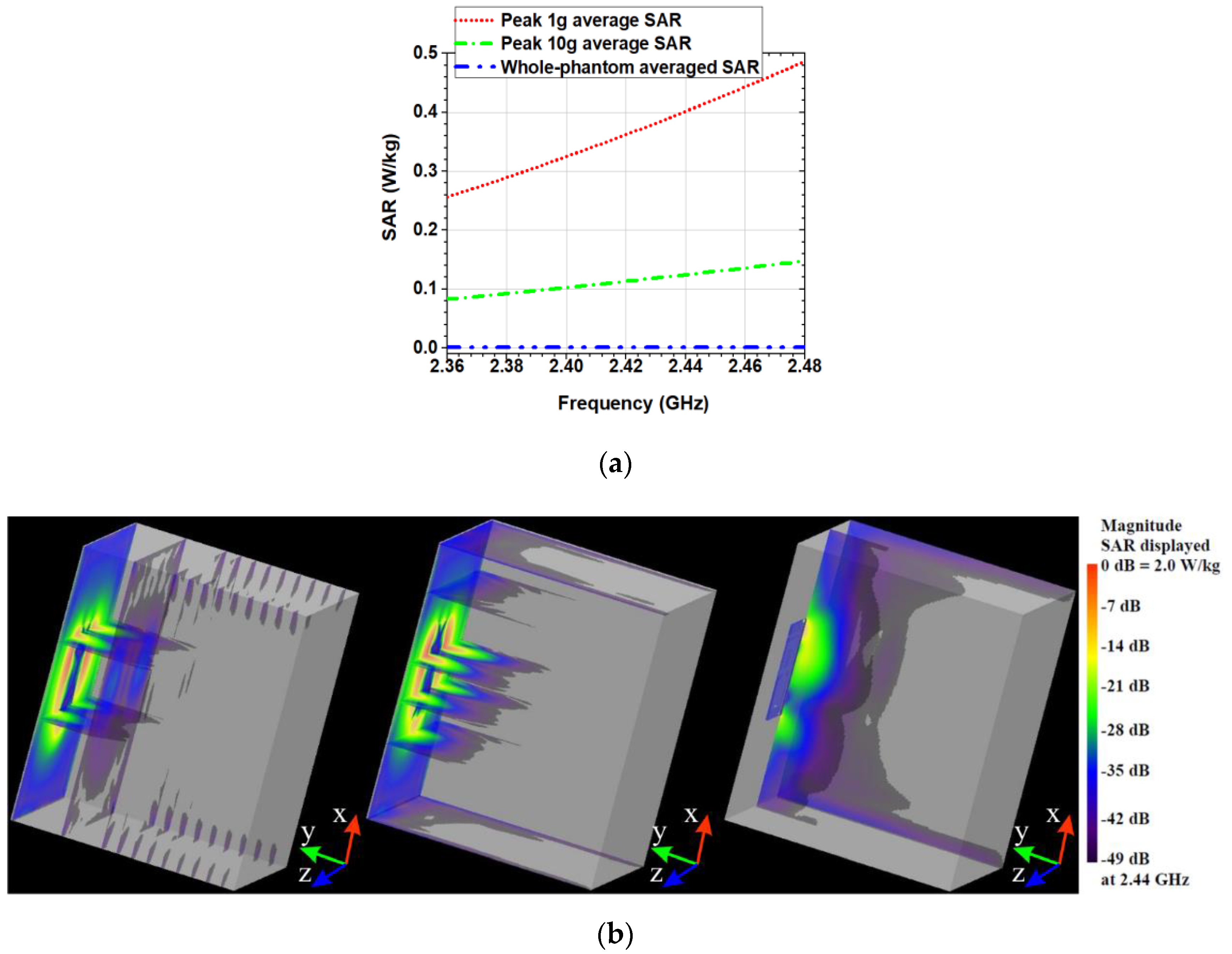


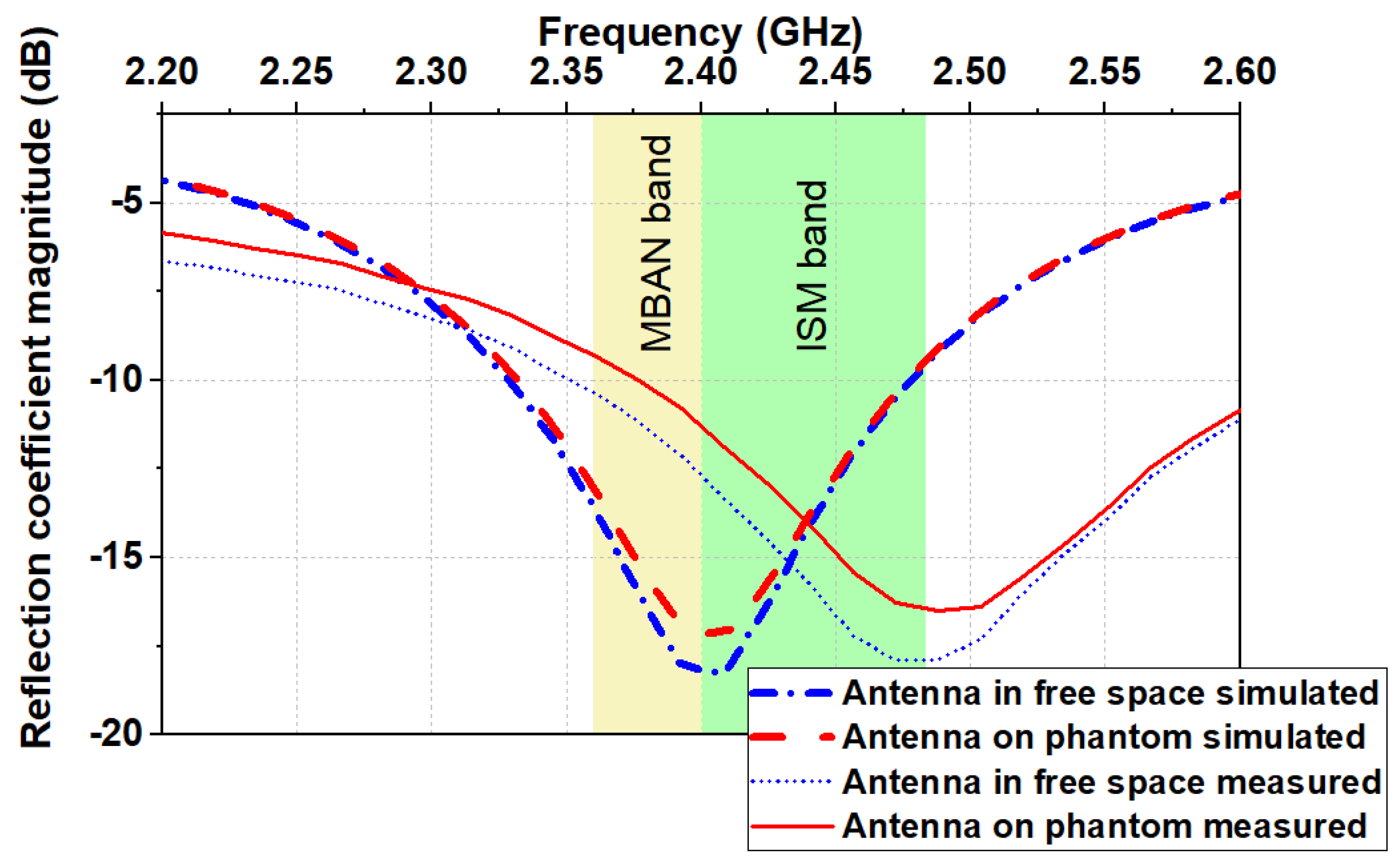

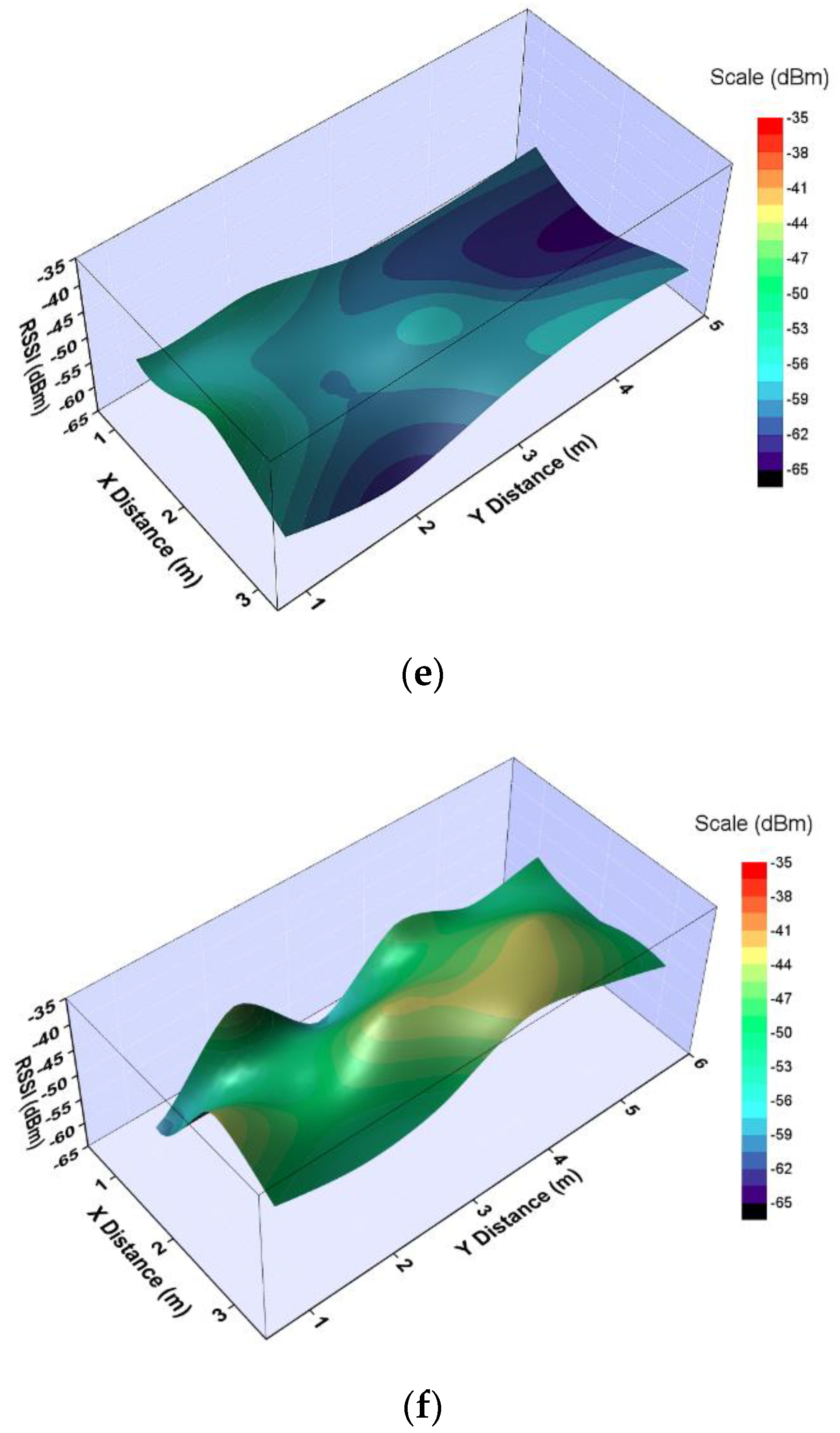
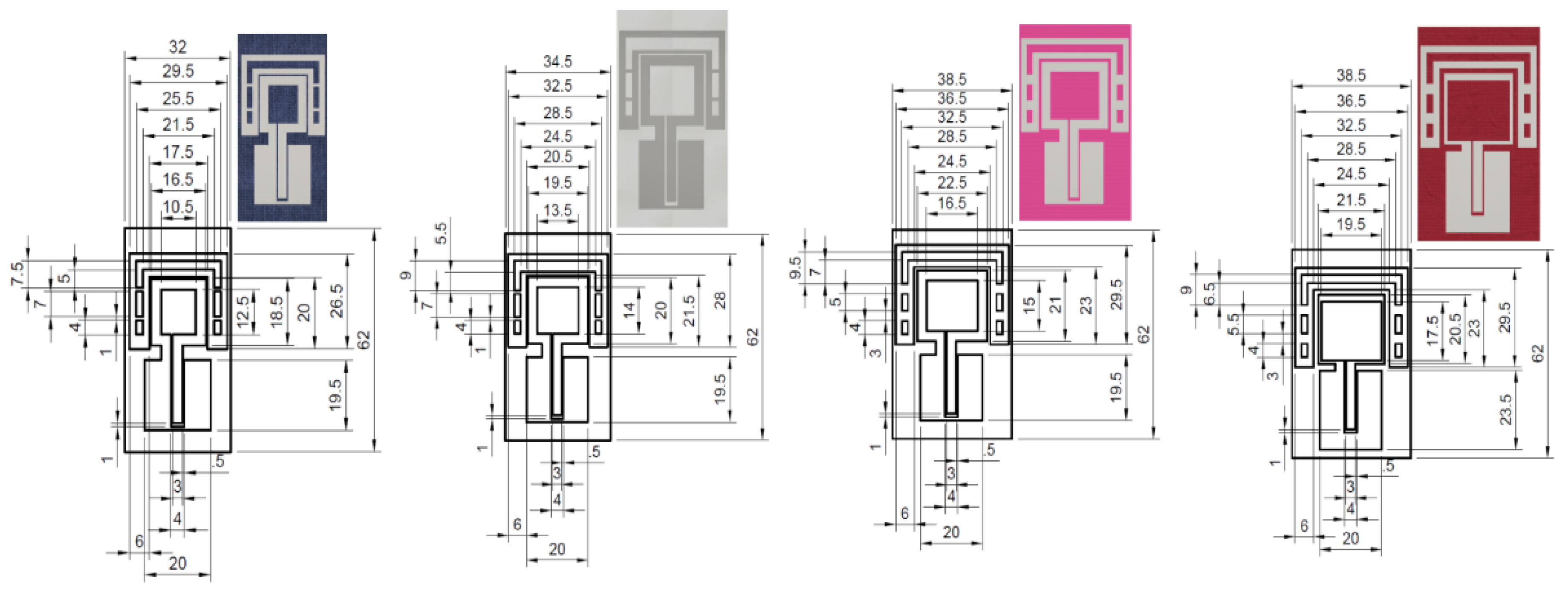

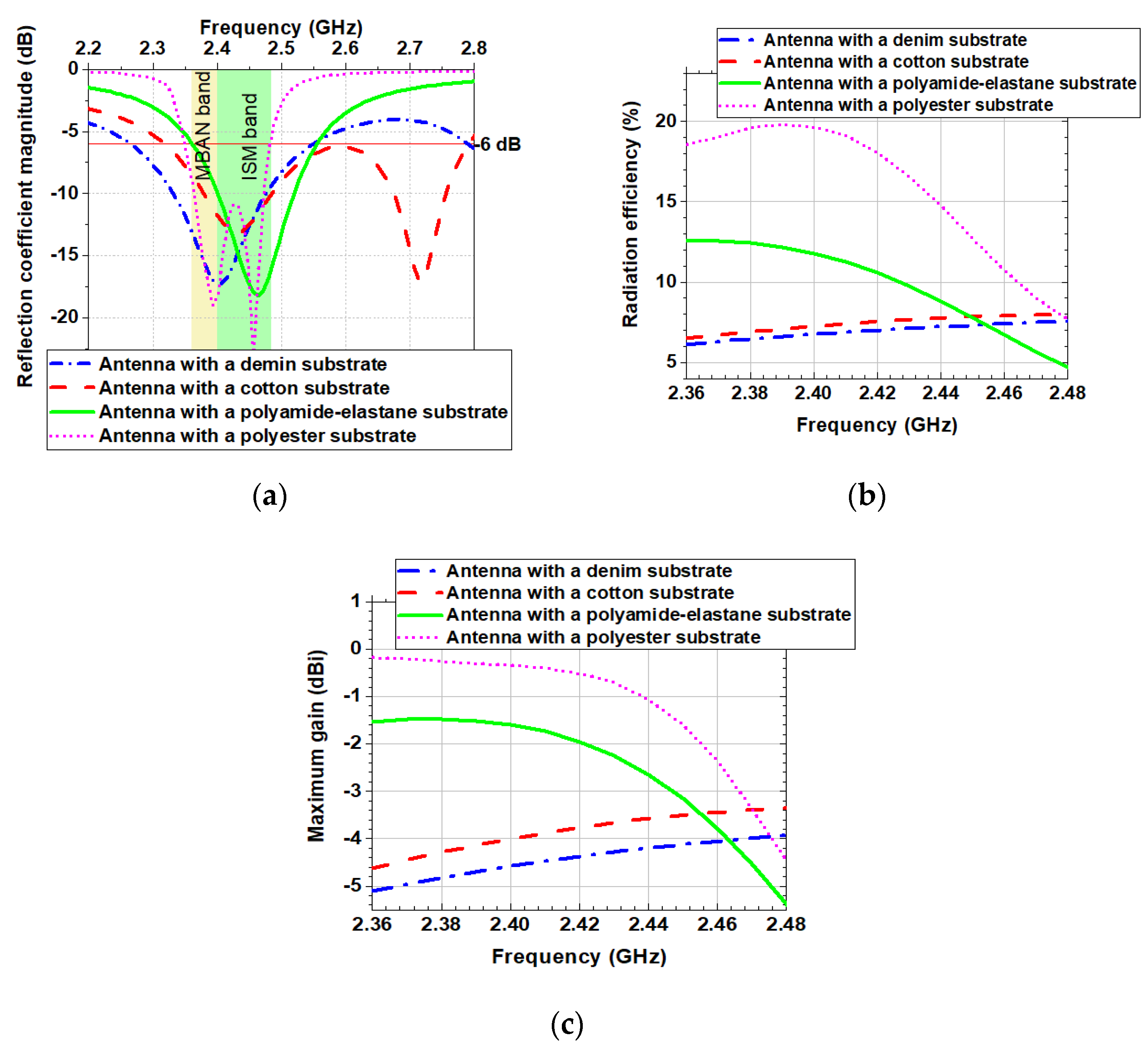


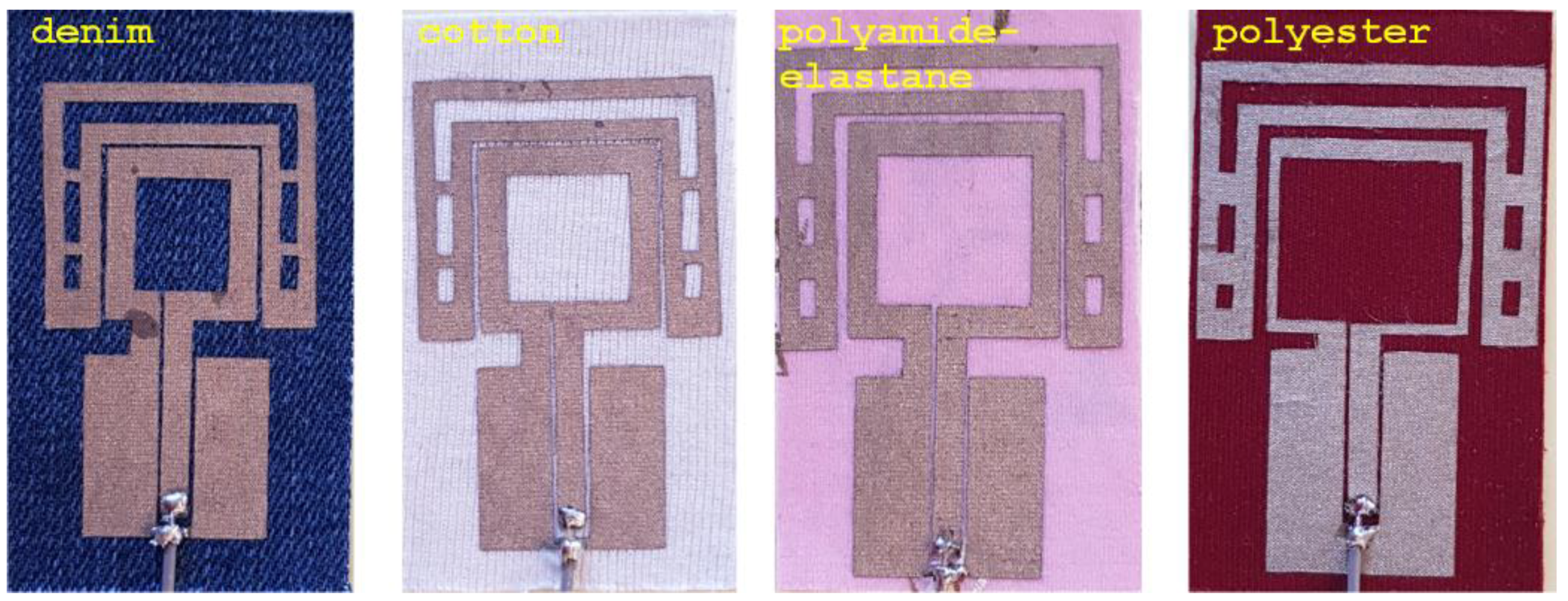

| Antenna Specification | |
|---|---|
| Frequency range (GHz) | 2.36–2.48 |
| |S11| in operating frequency range (dB) | ≤−6 |
| Minimum radiation efficiency on the human body (%) | ≥5 |
| Radiation pattern | unidirectional |
| Minimum front to back ratio (dB) | ≥10 |
| Peak 10 g average SAR (W/kg) | ≤2 |
| Maximum antenna size (cm2) | ≤25 |
| Maximum antenna profile (mm) | ≤1.5 |
| Maximum antenna weight (g) | ≤5 |
| Distance, mm | Maximum Net Input Power, mW | |||
|---|---|---|---|---|
| Denim | Cotton | Polyamide-Elastane | Polyester | |
| 0 | 1353 | 1062 | 176 | 104 |
| 5 | 4818 | 5133 | 961 | 397 |
| 10 | 9833 | 12,070 | 2806 | 1065 |
© 2020 by the authors. Licensee MDPI, Basel, Switzerland. This article is an open access article distributed under the terms and conditions of the Creative Commons Attribution (CC BY) license (http://creativecommons.org/licenses/by/4.0/).
Share and Cite
Atanasova, G.; Atanasov, N. Small Antennas for Wearable Sensor Networks: Impact of the Electromagnetic Properties of the Textiles on Antenna Performance. Sensors 2020, 20, 5157. https://doi.org/10.3390/s20185157
Atanasova G, Atanasov N. Small Antennas for Wearable Sensor Networks: Impact of the Electromagnetic Properties of the Textiles on Antenna Performance. Sensors. 2020; 20(18):5157. https://doi.org/10.3390/s20185157
Chicago/Turabian StyleAtanasova, Gabriela, and Nikolay Atanasov. 2020. "Small Antennas for Wearable Sensor Networks: Impact of the Electromagnetic Properties of the Textiles on Antenna Performance" Sensors 20, no. 18: 5157. https://doi.org/10.3390/s20185157
APA StyleAtanasova, G., & Atanasov, N. (2020). Small Antennas for Wearable Sensor Networks: Impact of the Electromagnetic Properties of the Textiles on Antenna Performance. Sensors, 20(18), 5157. https://doi.org/10.3390/s20185157





